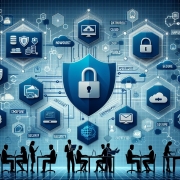Check Point Harmony Endpoint provides advanced threat prevention with centralized management and seamless integration, safeguarding networks through robust security features and real-time threat detection. It excels at ransomware prevention, encryption protection, and detailed threat analysis.


| Product | Market Share (%) |
|---|---|
| Check Point Harmony Endpoint | 2.4% |
| Microsoft Defender for Endpoint | 9.5% |
| CrowdStrike Falcon | 7.8% |
| Other | 80.3% |
| Type | Title | Date | |
|---|---|---|---|
| Category | Endpoint Protection Platform (EPP) | Nov 7, 2025 | Download |
| Product | Reviews, tips, and advice from real users | Nov 7, 2025 | Download |
| Comparison | Check Point Harmony Endpoint vs CrowdStrike Falcon | Nov 7, 2025 | Download |
| Comparison | Check Point Harmony Endpoint vs Microsoft Defender for Endpoint | Nov 7, 2025 | Download |
| Comparison | Check Point Harmony Endpoint vs SentinelOne Singularity Complete | Nov 7, 2025 | Download |
| Title | Rating | Mindshare | Recommending | |
|---|---|---|---|---|
| CrowdStrike Falcon | 4.3 | 7.8% | 97% | 135 interviewsAdd to research |
| Microsoft Defender for Endpoint | 4.1 | 9.5% | 94% | 198 interviewsAdd to research |
| Company Size | Count |
|---|---|
| Small Business | 77 |
| Midsize Enterprise | 37 |
| Large Enterprise | 49 |
| Company Size | Count |
|---|---|
| Small Business | 645 |
| Midsize Enterprise | 313 |
| Large Enterprise | 558 |
Check Point Harmony Endpoint is renowned for its comprehensive security features, including anti-ransomware capabilities and centralized management. It integrates seamlessly with existing systems, enhancing network protection through features like SandBlast Agent and threat emulation. Organizations benefit from significant incident reductions, utilizing its powerful threat detection, forensics, VPN capabilities, and robust encryption measures. Centralized management during remote work setups and enhanced security through URL filtering and rollback mechanisms further solidify its efficiency. Despite its high resource consumption and configuration challenges, it remains a preferred choice among enterprises aiming to enhance cybersecurity measures.
What Key Features Does Check Point Harmony Endpoint Offer?In sectors such as finance and healthcare, Check Point Harmony Endpoint is crucial for maintaining data security and regulatory compliance. Its features cater to endpoint protection requirements across industries, providing reliable solutions for encryption and cybersecurity challenges. The tool's deployment across diverse environments secures endpoint systems effectively, ensuring uninterrupted operations amid evolving threats.
Check Point Harmony Endpoint was previously known as Check Point Endpoint Security, Endpoint Security, Check Point SandBlast Agent, Check Point Antivirus.
Boston Properties, Independence Care System, Melbourne Convention and Exhibition Centre (MCEC), Courtagen Life Sciences, Carmel Partners
| Author info | Rating | Review Summary |
|---|---|---|
| Team Lead, Network & Security at a integrator with 11-50 employees | 4.0 | I find Check Point Harmony Endpoint effective and well-integrated with ThreatCloud AI, though it's resource-intensive for users with lower-spec devices. It's stable, scalable, and secure, but requires improvement in performance for broader deployment across our organization. |
| Pre Sales Consultant at Redington Group | 4.0 | We use Check Point Harmony Endpoint for malware, exploit, and ransomware protection, appreciating its comprehensive XDR features. Although policy customization is challenging, the solution has improved investigation speed and reduced alerts, showing a great return on investment. |
| Engineer Cyber Security at a computer software company with 201-500 employees | 4.5 | I've used Check Point Harmony Endpoint for a year to secure my device from malware and phishing; it's effective, especially with its threat prevention and unified console, though it could improve performance and simplify policy management. |
| Network Security Engineer at Binary Global Ltd | 5.0 | We are testing Check Point Harmony Endpoint on various systems, noting its centralized management and improved security. While performance during scans needs enhancement, it still offers substantial ROI by reducing cleanup costs and minimizing data breaches. |
| Senior Solution Consultant at a tech services company with 51-200 employees | 4.5 | I use Check Point Harmony Endpoint primarily as an EDR solution for threat detection and incident response. Its AI-powered threat prevention and scalability are valuable, though integration with other security solutions needs improvement. It outperforms Broadcom, with better ROI. |
| Technical Specialist at Softcell Technologies Limited | 4.5 | We use Check Point Harmony Endpoint for unified threat prevention, appreciating its anti-ransomware and phishing protection features. Centralized management is effective, but the agent could be lighter. It's a worthwhile investment, minimizing disruptions and enhancing security. |
| Senior Security Analyst at SecurView Systems Pvt Ltd | 4.5 | I use Check Point Harmony Endpoint to secure our organization's endpoints, appreciating its robust malware protection and management ease. Initial deployment is complex, but it offers a clear ROI by reducing time and manual efforts compared to previous solutions. |
| Sr. Technical Support Executive at Digitaltrack | 4.0 | I've used Check Point Harmony Endpoint for over three years to protect against threats and ransomware; it's effective with strong features like device control and central management, though its heavy agent slows down PCs slightly. |